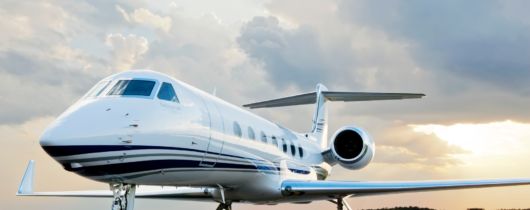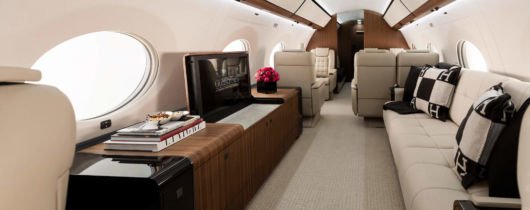
Technological advancements in the world of aviation have rendered time and distance nearly obsolete. Ultra long-range jets mitigate the challenges of long-distance travel by transporting passengers farther, faster and in more comfort than ever before.
Here, we define the characteristics of an ultra long-range private jet and compare the most popular models when it comes to long range high performance.
What Is an Ultra Long-Range Private Jet?
Generally speaking, ultra long-range private jets can achieve at least a nonstop range of 5,000 nm / 5,753 standard miles.
Ultra long-range private jets are primarily designed to avoid what are typically necessary and more frequent fuel stops made by smaller class private jets during long-distance flights. Along with the benefit of not stopping for fuel, ultra long-range business jets frequently offer features including:
● Multiple lavatories
● A fully equipped galley able to preserve and prepare meals
● Multiple zone seating areas with berthing capabilities
● A lower differential cabin pressure altitude
● Crew rest area for a third pilot to maximize crew duty time
● More sizable baggage space
By virtue of long-range, non-stop capabilities, these luxury aircraft can even provide a heightened level of security. Ultra long-range private jets are able to circumvent entire regions that are considered undesirable air spaces or deviate around unfavorable weather factors and still reach their final destination. While eliminating fuel stops and staying at altitude for long periods of time, these aircraft are able to maximize fuel efficiency, which is an added benefit when it comes to achieving longer flights.
The estimated cruising speed of ultra long-range private jets is approximately 500 knots (or 575 miles per hour) among most models.
Ultra Long-Range Private Jet Comparison Chart
For the purposes of comparison, we are including sample aircraft that can exceed 5,000 nautical miles of nonstop flight. We will exclude Boeing and Airbus VIP size aircraft, as they typically compete within their own category.
The following data was sourced using Conklin & de Decker, an industry supplier of business aircraft information. As such, this data should be viewed as average, since actual performance may be influenced by a certain departure airport, cruising speed selected, and prevailing winds among other factors.
The following are the most popular models considered for ultra long-range travel.
| Manufacturer | Model | Range (nm) | Passengers | Avg. Price (New) |
| Bombardier | Global 5500 | 5,934 | 12 | $47.4 m |
| Global 6500 | 6,563 | 14 | $58 m | |
| Global 7500 | 7,474 | 19 | $81 m | |
| Dassault | Falcon 7X | 5,466 | 12 | $54 m |
| Falcon 8X | 6,290 | 12 | $63 m | |
| Gulfstream | G500 | 5,067 | 13 | $48 m |
| G550* | 6,583 | 18 | N/A | |
| G600 | 6,310 | 13 | $59 m | |
| G650ER | 6,985 | 13 | $70 m | |
| Pending Certification (as of 9/1/2023) | ||||
| Bombardier | Global 8000 | 8,000 | 19 | TBD |
| Dassault | Falcon 10X | 7,500 | 19 | TBD |
| Gulfstream | G700 | 7,150 | 13 | $78 m |
| Gulfstream | G800 | 8,000 | 8 | TBD |
*Out of production
Long Range Jet Considerations
When comparing the advantages of ultra long-range jets, it’s important to weigh the cost versus the benefit. Potential buyers can assume a price point for ultra long-range jets in the highest category of the private jet market; therefore, when evaluating the need for long-distance trips, buyers can and should anticipate the additional necessary capital investment. If the lower price point and performance of a smaller private jet meets the requirements for a high majority of planned travel, the remaining ultra long-range trips could possibly be accomplished by way of chartering an ultra long-range private jet.
There are some operational characteristics that naturally accompany ultra long-range private aircraft ownership and operation. For example, some private or non-commercial airports have limitations on maximum ramp weight as well as maximum wingspan. An aviation consultant should be able to confirm the details of your anticipated airport profiles to note any limitations.
Other important considerations include:
- Annual flight hours: Do you fly frequently and far enough that an ultra long-range jet would be a natural asset to your business or personal activities? Or would chartering that class of private jet for those missions be a more cost-effective option and acceptable to your needs and personal requirements?
- Expected passengers / payload: Do you regularly transport heavy cargo or more than a dozen passengers per trip? While some ultra long-range aircraft can accommodate up to 19 passengers and their luggage, a greater payload can compromise the aircraft’s maximum performance and range by limiting the maximum amount of fuel.
- The possibility of chartering: Will you charter out your aircraft? Chartering carries a range of considerations (typical of owning any private aircraft), but there is ample charter demand specifically for aircraft with ultra long-range capability. If chartering is of interest, it is best to discuss the aspects of doing so with an aviation consultant.
- Fixed and variable costs: As would be expected, the expenses of owning and operating an ultra long-range jet deserve consideration. While hourly operating costs for larger aircraft are generally higher, there will also be added fixed costs that apply, such as with insurance (higher hull value), hangar storage (being a larger aircraft) as well as higher costs for crew training and salaries.
- Depreciation: All aircraft models are expected to depreciate in value over time, and as time has proven, the rate of depreciation can be greater or less than what is expected. However, working with an experienced aviation consultant who can leverage industry knowledge will help identify and explain which aircraft models (and even which specific aircraft) are more apt to hold their value at a greater level.
Why Choose an Ultra Long-Range Private Jet?
All things considered, an ultra long-range jet is often the best choice for individuals or businesses who require unique cabin features and amenities, are able to appreciate the added security and efficiencies, and anticipate frequent international flights with the need to minimize travel time and enjoy maximum travel comfort.
Ultra long-range private jet owners enjoy the following benefits:
- Direct, nonstop flights between distant cities and destinations
- Less total time spent traveling
- Amenities that contribute to a more comfortable and convenient travel experience
- Higher speeds and altitudes than commercial airliners can offer
- Higher passenger capacity compared to smaller class private jets
- Ability to add a crewmember for longer flights with a designated crew rest area
- In some cases, up to 14 hours of flight without a fuel stop
- More luxurious cabins with different seating arrangements, sleeping quarters, entertainment systems, world-wide communications, etc.
- A full service galley with capabilities to prepare full course meals
- A forward and aft lavatory
- Advanced avionics systems, which provide state-of-the art navigation and communication technology
- Increased fuel efficiency due to operating at sustained, high-altitudes
- Ability to overfly or completely avoid certain higher-risk parts of the world while reaching your final destination
If you are considering acquiring an ultra long-range jet for personal or business use, connect with an aviation consultant such as those at Essex Aviation. With decades of experience in all aspects of the aviation industry, our team of experts leaves no stone unturned when it comes to finding the ideal aircraft for your unique needs and preferences.
Reach out for a free consultation with Essex today.
Frequently Asked Questions
How far can ultra long-range private jets fly?
Generally speaking, ultra long-range jets can achieve a nonstop range of 5,000 to 7,500 nautical miles, while flying at a cruising speed of approximately 500 knots (575 miles per hour).
What is the longest range jet?
When we consider ultra long-range as being in the realm of 5,000 – 7,500 nautical miles, the three (3) primary ultra long-range private aircraft manufacturers are Bombardier, Dassault and Gulfstream. Bombardier first entered this category with the Global 7500, now in existence for several years, delivering well over 150 aircraft; development of a Global 8000 is currently underway. Gulfstream also now competes squarely in this range with their G700 and G800, to be certified in the near future. Along with these contenders is the Dassault 10X, still well in the pre-certification process, but which promises to be a leader in a category of maximum range and offer unique technology and both crew and passenger cabin features.







